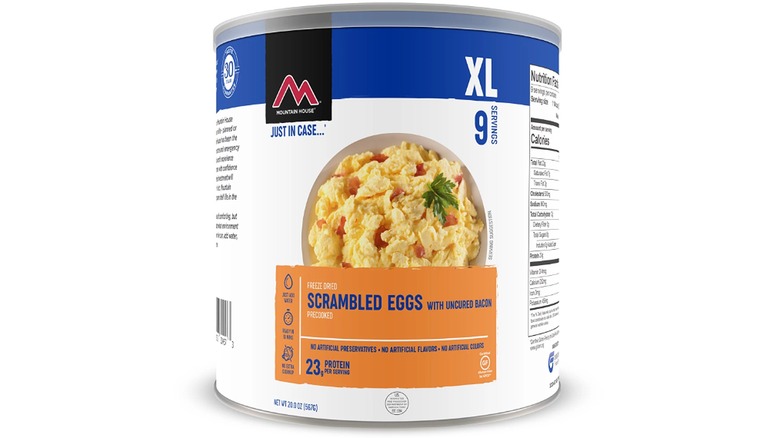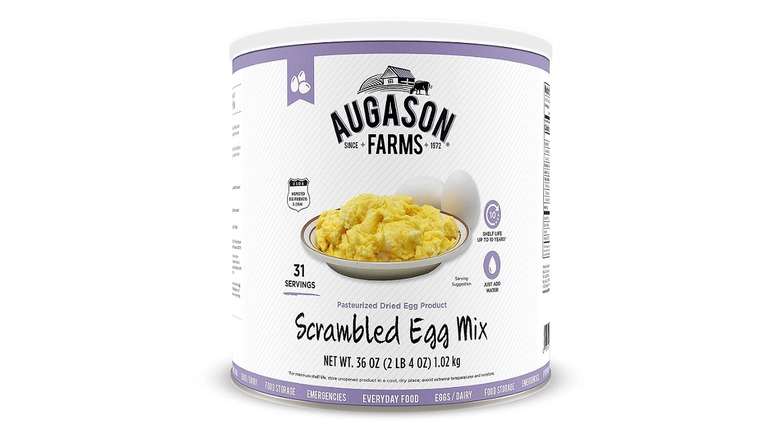Canned Scrambled Eggs Are A Thing — Here's How To Use Them
We may receive a commission on purchases made from links.
Canned food in general often gets a bad rap as being not as tasty or healthy as the fresh or frozen kind, but the reason why so many kinds of foods — even unlikely ones like scrambled eggs — come in for the canning treatment is because shelf stability is a necessity in circumstances where refrigeration is not an option.
One of the earliest adopters of canned foods was the military, as the first such items appeared during the Napoleonic Wars. While we don't have an exact date for the creation of canned scrambled eggs, we do know that powdered eggs date back to the 19th century and were marketed as a way to address the U.K.'s soaring egg prices during WW1. By WWII, canned scrambled eggs that did come in cans were included in the C-rations and K-rations that were among the ready-made meals carried by troops U.S. in the field up through the Vietnam War.
These days, freeze-dried scrambled eggs in a can are sold by retailers such as REI and Walmart. While they are touted as suitable for backpacking and camping in general, these dried eggs in a can are also a staple in some prepper pantries because survivalists see the necessity of stockpiling food that can be stored for a long period of time.
What are canned scrambled eggs?
In decades past, the kind of canned scrambled eggs that came in military C-rations were, in fact, pre-cooked and could be consumed cold. These might also have been accompanied by bits of cured or cooked ham that were mixed into the eggs.
The canned scrambled eggs that are readily available today, however, are not ready to eat. Rather, these products consist of dried eggs that have been sealed into an airtight can for storage purposes. Before you eat the eggs, they'll need to be reconstituted with water and cooked, although combining these two steps may be possible if boiling water is used. The packaging of the Mountain House brand of freeze-dried canned scrambled eggs suggests that as long as the can is sealed, the product might remain safe for human consumption for as long as three decades. This may only apply, however, if the eggs are stored under optimal conditions, meaning a cool, dry, dark place with a temperature above freezing but below 75 F.
How are canned scrambled eggs made?
Several different methods are used to dehydrate scrambled raw eggs for commercial purposes including low temperature drying and spray drying, but some methods seem more tailored towards producing the type of powdered eggs used for commercial food manufacture. Some commonly available types of canned scrambled eggs are instead produced by freeze-drying, a method that involves combining the yolks and whites, freezing them, and then using a room-temperature vacuum process of dehydrating. Freeze-dried eggs are the kind best suited for long-term storage as they are the least susceptible to oxidation.
Home cooks, too, have experimented with several different ways of making their own canned scrambled eggs. One person on the Homesteading Today forum reported first cooking some scrambled eggs, then pressure canning them in a jar, and described the results as "okay" although the eggs kind of cohered into one semi-solid mass. Others, however, recommend dehydrating eggs rather than canning them for a long-term storage solution.
One method, which is safer but results in eggs that may not taste so great, involves cooking the eggs first, then dehydrating them until they can be ground to a powder. Another makes use of a food dehydrator to dry beaten raw eggs. The problem here is that many commercial dryers don't reach a high enough temperature (160 F) to kill off any potential salmonella bacteria. The resulting eggs may be risky, but Commercial Dehydrators America says they can be stored in cans for up to 10 years.
What do canned scrambled eggs taste like?
The canned scrambled eggs used by the military in the mid-20th century were, by some accounts, not terribly popular with the troops. While one WWII soldier called the canned eggs included in K-rations "marvelous" in an interview with the Veterans' Oral History Project, he followed this up with an anecdote about how they used to throw them at things, possibly implying that his compliment was meant to be facetious. A few Vietnam-era veterans commenting on the City-Data forum recalled that the 1970s version of canned eggs was practically inedible. A commenter even called them "one of the worst things I ever tasted out of a can."
Several people who tried canning their own eggs did so with mixed results. While the person who pressure-canned cooked scrambled eggs (via Homesteading Today) found them fairly tolerable, another person who used a dehydrator to make powdered canned eggs noted on the Backwoods Home website that they really only worked for baking. When used to make scrambled eggs, they admitted, "The taste was grainy and bad enough for me to swish my mouth out with water after one bite"
Commercially available canned scrambled eggs, too, are not exactly comparable to fresh ones. While the Augason Farms brand has a 4.6-star rating from Amazon users, some of the comments regarding the actual taste include "a little grainy" and "They don't taste the best, but it's edible."
How to cook with canned scrambled eggs
If you purchase the kind of dried eggs that come in a can today, as opposed to opening up an ancient can of C-rations (which we really don't recommend doing), you will most likely need to reconstitute them, either the entire can at a time or a measured portion thereof. While the Mountain House Brand requires boiling water, the Auguson Farms label says that the dried eggs should be rehydrated with warm water and then cooked.
Those who've eaten reconstituted canned scrambled eggs, though, often recommend including them in other recipes such as breakfast tacos, skillets, or scrambles since additional ingredients help to camouflage any defects in the eggs' taste or texture. What you will need to do is to first reconstitute the eggs, then add them to pre-cooked meats and/or vegetables such as chopped ham, sausage, peppers, and onions. You might also wish to add some grated cheese right at the end or sprinkle it over the top of the cooked eggs so that it can melt in their residual heat (carryover cooking at its finest).
One tip for backpackers is to combine the eggs with other types of lightweight, shelf-stable foods such as sun-dried tomatoes or bacon bits. That way, these items can all rehydrate together and be cooked up into a fairly flavorful scramble.
Where to buy canned scrambled eggs
Canned scrambled eggs seem to be something that can be purchased right off the shelves at Walmart, although you'll need to check the website to see whether your particular Walmart has them in stock. Camping and outdoor supply stores may also offer similar types of dehydrated eggs, as could sporting goods stores such as Dick's or even farm stores. Some of these retailers, however, may be more likely to sell this product in individually-sized pouches rather than in the larger cans favored by preppers.
If you shop online, though, a number of survival-oriented websites will be happy to sell you large cans of dried scrambled eggs, as will Amazon, of course. Yet another option, should you be located in Thailand, is to order canned scrambled eggs via the delivery app FoodPanda. "Canned scrambled eggs with rice and drinking water" is offered as a FoodPanda exclusive menu item priced at 79 Thai baht, which is equivalent to approximately $2.25.
Nutritional information about canned scrambled eggs
A ½ cup serving of Auguson Farms canned scrambled egg mix is the equivalent of about two fresh eggs. According to the packaging, this serving has 180 calories, 13 grams of fat (3.5 saturated), 12 grams of protein, 6 grams of carbohydrate, and 250 milligrams of sodium. A fairly similar portion of the Mountain House brand contains 175 calories, 11.5 grams of fat (3.5 saturated), 11.5 grams of protein, 6 grams of carbohydrate, and 430 milligrams of sodium. Two large fresh eggs, in contrast, yield 143 calories, 9.5 grams of fat (3 saturated), 12.5 grams of protein, less than 1 gram of carbohydrate, and 142 milligrams of sodium.
Wherein lies the difference? While home-dried eggs may be made from nothing more than eggs alone, both brands of commercially produced canned eggs contain various additives. The Auguson Farms brand includes dried milk, soybean oil, and salt, while the Mountain House one is made with tapioca starch, sunflower oil, salt, smoke flavoring, and xanthan gum. The latter product also includes bits of cooked bacon that boost the sodium count with additional salt of their own.






